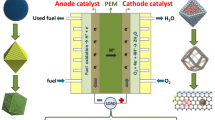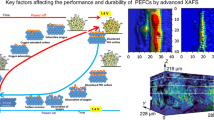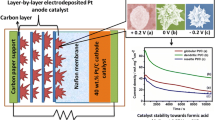Abstract
Solid acid fuel cells based on CsH2PO4 as the electrolyte and Pt as the electrocatalyst are a promising intermediate temperature energy conversion technology. However, improving the electrode microstructure to achieve an optimal area-normalized resistance, while keeping or even lowering the Pt catalyst loading is particularly challenging due to the solid nature of the electrode components. Several architectures have been empirically developed, such as CsH2PO4 micro- or nanoparticles mixed with Pt nanoparticles or covered with thin-film Pt. For an optimal electrode design, a quantitative measurement of the fundamental parameter, namely the specific triple-phase boundary activity of Pt at the fuel cell operating conditions, is needed. Geometrically simple, well-controlled electrodes are typically fabricated for this purpose via lithography techniques. This approach however is not suitable for solid acids due to the water solubility of the electrolyte. Here we present a simple, water-free fabrication scheme to create a controlled electrode geometry consisting of a hole-patterned Pt thin film that allows measurements of the specific triple-phase boundary activity of Pt in an anodic environment. Based on electrochemical impedance spectroscopy measurements in a symmetric cell configuration, the triple-phase boundary activity of Pt is determined to be on the order of 1.3 kΩ m. This information is critical for the rational design of a solid acid fuel cell electrode without tedious empirical optimization.
Graphical abstract










Similar content being viewed by others
References
Larminie J, Dicks A (2003) Fuel cell systems explained. 2 edn. Wiley, New York
Guenot B, Cretin M, Lamy C (2015) Clean hydrogen generation from the electrocatalytic oxidation of methanol inside a proton exchange membrane electrolysis cell (PEMEC): effect of methanol concentration and working temperature. J Appl Electrochem 45(9):973–981. doi:10.1007/s10800-015-0867-3
Haile SM, Chisholm CRI, Sasaki K, Boysen DA, Uda T (2007) Solid acid proton conductors: from laboratory curiosities to fuel cell electrolytes. Faraday Discuss 134:17. doi:10.1039/b604311a
Chisholm CRI, Boysen DA, Papandrew AB, Zecevic SK, Cha S, Sasaki KA, Varga Á, Giapis KP, Haile SM (2009) From laboratory curiosities to technological realization: the development path for solid acid fuel cells. Interface Mag 18:53–59
Boysen DA, Uda T, Chisholm CRI, Haile SM (2004) High-performance solid acidfuel cells through humidity stabilization. Science 303:68–70
Uda T, Haile SM (2005) Thin-membrane solid-acid fuel cell. Electrochem Solid-State Lett 8(5):A245. doi:10.1149/1.1883874
Markovic NM, Schmidt TJ, Stamenkovic V, Ross PN (2001) Oxygen reduction reaction on Pt and Pt bimetallic surfaces: a selective review. Fuel Cells 1(2):105–116
Antonlini E (2004) Recent developments in polymer electrolyte fuel cell electrodes. J Appl Electrochem 34:563–576
Son DN, Gam NT, Takahashi K (2016) Ab-initio study of surface oxide formation in Pt(111) electrocatalyst under influences of O2-containing intermediates of oxygen reduction reaction. J Appl Electrochem 46(10):1031–1038. doi:10.1007/s10800-016-0982-9
Barron O, Su H, Linkov V, Pollet BG, Pasupathi S (2014) CsHSO4 as proton conductor for high-temperature polymer electrolyte membrane fuel cells. J Appl Electrochem 44(9):1037–1045. doi:10.1007/s10800-014-0715-x
Varga Á, Brunelli NA, Louie MW, Giapis KP, Haile SM (2010) Composite nanostructured solid-acid fuel-cell electrodes via electrospray deposition. J Mater Chem 20(30):6309. doi:10.1039/c0jm00216j
Suryaprakash RC, Lohmann F, Wagner M, Abel B, Varga A (2014) Spraydrying as a novel and scalable fabrication method for nanostructured CsH2PO4, Pt-thin-film composite electrodes for solid acid fuel cells. RSC Adv 4:60429–60436. doi:10.1039/c4ra10259b
Thoi VS, Usiskin RE, Haile SM (2015) Platinum-decorated carbon nanotubes for hydrogen oxidation and proton reduction in solid acid electrochemical cells. Chem Sci 6 (2):1570–1577. doi:10.1039/c4sc03003f
Papandrew AB, Chisholm CRI, Elgammal RA, Özer MM, Zecevic SK (2011) Advanced electrodes for solid acid fuel cells by platinum deposition on CsH2PO4. Chem Mater 23(7):1659–1667. doi:10.1021/cm101147y
Louie MW, Haile SM (2011) Platinum thin film anodes for solid acid fuel cells. Energy Environ Sci 4(10):4230. doi:10.1039/c1ee01889b
Fredriksson H, Alaverdyan Y, Dmitriev A, Langhammer C, Sutherland DS, Zäch M, Kasemo B (2007) Hole–mask colloidal lithography. Adv Mater 19(23):4297–4302. doi:10.1002/adma.200700680
Bieberle A, Meier L, Gauckler L (2001) The electrochemistry of Ni pattern anodes used as solid oxide fuel cell model electrodes. J Electrochem Soc 158(6):A646–A656
Fleig J, Baumann FS, Brichzin V, Kim HR, Jamnik J, Cristiani G, Habermeier HU, Maier J (2006) Thin film microelectrodes in SOFC electrode research. Fuel Cells 6(3–4):284–292. doi:10.1002/fuce.200500209
Bessler WG, Vogler M, Stormer H, Gerthsen D, Utz A, Weber A, Ivers-Tiffee E (2010) Model anodes and anode models for understanding the mechanism of hydrogen oxidation in solid oxide fuel cells. Phys Chem Chem Phys 12 (42):13888–13903. doi:10.1039/c0cp00541j
Koep E, Compson C, Liu M, Zhou Z (2005) A photolithographic process for investigation of electrode reaction sites in solid oxide fuel cells. Solid State Ion 176(1–2):1–8. doi:10.1016/j.ssi.2004.07.012
Hertz J, Tuller H (2004) Electrochemical characterization of thin films for a micro-solid oxide fuel cell. J Electroceram 13:663–668
Wickman B (2010) Nanostructured model electrodes for studies of fuel cell reactions. Chalmers University of Technology, Göteborg
Kim YB, Hsu C-M, Connor ST, Gür TM, Cui Y, Prinz FB (2010) Nanopore patterned Pt array electrodes for triple phase boundary study in low temperature SOFC. J Electrochem Soc 157(9):B1269–B1274
Brown EC, Wilke SK, Boyd DA, Goodwin DG, Haile SM (2010) Polymer sphere lithography for solid oxide fuel cells: a route to functional, well-defined electrode structures. J Mater Chem 20(11):2190. doi:10.1039/b920973e
Paulus U, Wokaun A, Scherer GG, Schmidt T, Stamenkovic V, Markovic NM, Ross PN (2002) Oxygen reduction on high surface area Pt-based alloy catalysts in comparison to well defined smooth bulk alloy electrodes. Electrochim Acta 47:3787–3798
Costamagna P, Costa P, Atonucci V (1998) Micro-modeling of solid oxide fuel cell electrodes. Electrochim Acta 43(3–4):375–394
Bessler WG, Gewies S, Vogler M (2007) A new framework for physically based modeling of solid oxide fuel cells. Electrochim Acta 53(4):1782–1800. doi:10.1016/j.electacta.2007.08.030
Deseure J, Bultel Y, Dessemond L, Siebert E (2005) Theoretical optimisation of a SOFC composite cathode. Electrochim Acta 50(10):2037–2046. doi:10.1016/j.electacta.2004.09.012
Acknowledgements
The authors acknowledge Dietmar Hirsch and Andrea Prager for scanning electron microscopy and the funding through the ESF-Forschergruppe ‘Applied and theoretical molecular electrochemistry as a key for new technologies in the area of energy conversion and storage’.
Author information
Authors and Affiliations
Corresponding author
Rights and permissions
About this article
Cite this article
Abdelrahman, A., Abel, B. & Varga, A. Towards rational electrode design: quantifying the triple-phase boundary activity of Pt in solid acid fuel cell anodes by electrochemical impedance spectroscopy. J Appl Electrochem 47, 327–334 (2017). https://doi.org/10.1007/s10800-017-1050-9
Received:
Accepted:
Published:
Issue Date:
DOI: https://doi.org/10.1007/s10800-017-1050-9




